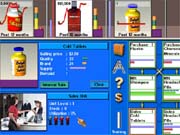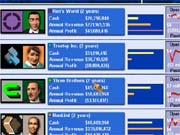Since the business world is as cutthroat and lucrative as it is, it's no surprise that it makes for great game material. But while some might think that all such games must have "Tycoon" somewhere in the title, Capitalism II sets its sights higher. If you play your cards right in Capitalism II and establish a globe-spanning corporation, it's not about wealth, but megawealth--counted in billions. The scale of this game is much more ambitious than that of other Tycoon games or business sims, providing a world where you can control everything from mining operations and media outlets to the manufacturing and retail of around 60 diverse products. This complexity means the game requires quite some effort to learn, but once competition picks up against the aggressive AI, Capitalism II shows its colors as a great strategy game. Also, as if to help your own bottom line, the game's a real bargain at $20.

At the heart of Capitalism II is a sophisticated game design that's been expanded and refined since the original version of Capitalism was released in 1995. Both Capitalism games were designed by Trevor Chan, who is also the creator of the Seven Kingdoms games, which innovatively combine real-time strategy combat with Civilization-style empire building. The core of Capitalism is straightforward: The object is to create businesses that buy, produce, or sell products and reinvest the profits to boost revenue and to diversify into new regions and products. Businesses are as customizable as you might hope. You don't need to devote one whole store to aspirin and another to cough syrup--there's a manageable four product slots you can allocate. Each business is made up of nine building blocks, such as crop growing, manufacturing, purchasing, sales, and advertising, but there are hundreds of easily searchable premade templates, so a working furniture factory is only a few clicks away.
Once you have some basic businesses turning a profit, the game really opens up. While there are usually a few decent retail goods available for import from nearby seaports, you'll soon have to move into manufacturing to keep your corporation growing. And to get the raw materials for your factories, you'll often have to get into farming, mining, or lumber. Even though it can take a lot of capital--whether from cash, loans, or a stock offering--to build this sort of infrastructure, there are ways of starting small. Over time, the key to massive success in the game is vertical integration--owning every part of the food chain from oil fields and plastic plants to toy factories, stores, and even the TV stations where you advertise.

Capitalism II adds new depth, as well as a more accessible presentation, to the original game. The first campaign is entirely devoted to tutorial scenarios that progressively walk you through the game's key mechanics and then provide an open-ended testing ground with a relatively simple goal. For those who have completed the tutorial and at least tried an open-ended random game, there's a second group of five scenarios that quickly ramps up the challenge. The game's interface has seen a number of improvements, including a much better menu system for finding products, automatic relinking of products to new suppliers, and more comprehensive automation for businesses that you can hand over to a well-paid chief operating officer. However, the interface is sorely lacking keyboard shortcuts--in fact, it's lacking any useful keyboard control. With so many lists and menus to scroll through, it would have been fast and helpful to be able to at least use the standard arrow and "page up" and "page down" keys. While the game may look like Quicken at times, it's not as user-friendly as real business applications have become.

While some of the game's mechanics are repetitive unless you hire a COO to do your dirty work, there's plenty of competitive drama to keep things from just being work. A real-time stock market not only offers additional possibilities for wealth but also allows for hostile takeover bids and other financial shenanigans. A new complex economy option also monitors the temperature of regional economies, which can dynamically swing from boom to bust. With some luck, it's possible to build or buy apartments and commercial office real estate during a downturn and offload them later when the market is hot. However, the game is ultimately about the traditional economic mainstays of retailing and manufacturing, and here it's variably meek or aggressive AI that makes things particularly interesting. In the more challenging scenarios, you'll be constantly looking for profitable niches that aren't already saturated with competition. With more than 60 products in the game, there's more than enough room to explore different options and strategies, but don't be surprised if at the most aggressive settings, the computer doesn't leave you alone in profitable markets for long.
Even at the lower levels of difficulty, there's some challenge to be found just in making businesses profitable. It always takes money to make money, and it can take some tweaking to the selling price or branding strategy to build up sufficient demand for a product. What makes Capitalism II so deep and satisfying over time in its modeling of traditional industries is that no two products are alike, thanks to a few key statistics that fundamentally affect what buyers look for in each category. For example, selling cola is little more than fancy marketing for sugar water, so naturally, brand is everything. But with a product like bread, brand is much less important than the other two considerations: price and quality. This combination of scope and specificity is what distinguishes Capitalism II from The Corporate Machine, another recent game with a much more abstract take on competitive business.

On the technical side, Capitalism II's production values don't match its gameplay. The isometric city graphics convey the sense of a bustling economy, and the amount of traffic on the streets and people on the sidewalks are a meaningful indication of prime locations. Except in the new and rather superfluous in-store views, the overall effect is that of function over form, but you might appreciate that when browsing through the numerous screens of statistics. Capitalism II does add multiplayer capabilities for up to seven players, including a player-matching service through Ubi.com and save-game feature; plus, with limited goals, the game's real-time mechanics are quick enough for competitive play. However, even over a LAN, the interface was noticeably sluggish during multiplayer matches, and it's possible for any player to alter the speed setting at any time, which is a potential point of abuse.
There's a lot of micromanagement to Capitalism II, but, like with good "Tycoon" games, that effort earns you addictive hours at the helm of a successful enterprise and vast virtual fortunes. The game has a steep learning curve, but there are real-world lessons to take away from it. The original Capitalism game saw some success among educators for its realistic yet manageable simulation of traditional corporations. If you have a basic idea about what makes businesses work, a thirst for competition, and some patience to learn the ropes, Capitalism II has a lot to offer.